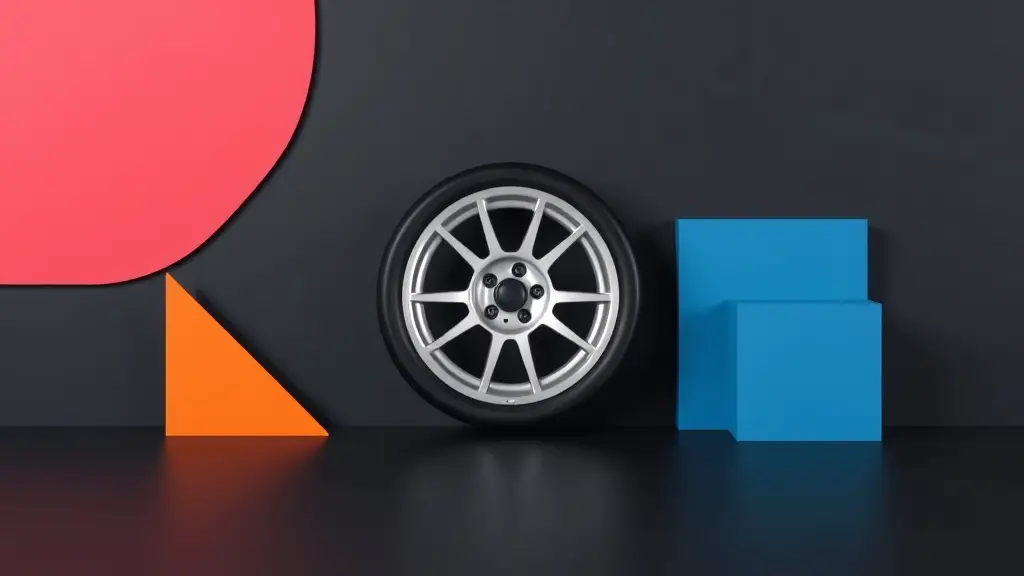19-inch wheels can definitely spice up a ride, giving it that sporty look. They often improve handling and braking, making turns sharper and stops quicker. But beware! The ride may get a bit bumpy, and you’ll hear more road noise. Plus, those fancy tires can cost a pretty penny to replace. If you’re after style and performance, these wheels might be for you, but it’s wise to contemplate the potential trade-offs before making a decision! Want to know more?
Main Points
- Larger 19-inch wheels enhance handling, providing better grip and stability during cornering and increased acceleration on straightaways.
- Improved braking performance is achieved with larger wheels, allowing for quicker stops and better heat dissipation.
- Aesthetic appeal is a pro, as 19-inch wheels give a sportier look, though they often come with higher tire costs and frequent replacements.
- Ride quality may suffer due to increased road noise and a stiffer ride, especially on rough surfaces, impacting long drive comfort.
- Fuel efficiency can decrease as larger wheels create more rolling resistance and add weight, potentially increasing maintenance costs and risks of pothole damage.
Do Larger Wheels Improve Handling?
When it comes to the question of whether larger wheels improve handling, one might wonder just how much difference those extra inches can make.
Larger wheels often mean wider tires, which can grip the road better. This can lead to sharper turns and a more stable ride, especially when cornering. Think of it like upgrading from a bicycle with tiny tires to one with big, beefy ones; it just feels more planted!
Nevertheless, it’s not all sunshine and rainbows. Bigger wheels can also make a car feel a bit stiffer, which might not be everyone’s cup of tea.
Pro #1. Improved Braking Performance
Improved braking performance is one of the standout benefits of upgrading to 19-inch wheels. When drivers swap out their smaller wheels for these larger ones, they often notice a notable difference in how quickly their vehicles come to a stop.
This is partly because 19-inch wheels can accommodate bigger brake components, which means more stopping power. Imagine slamming the brakes, and instead of a slow, gradual halt, you stop on a dime!
Plus, larger wheels offer better heat dissipation, reducing the chances of brake fade during intense situations, like those thrilling mountain drives.
Con #1. Increased Tire Replacement Costs
Upgrading to 19-inch wheels can certainly give a vehicle a sporty edge, but it’s not all fun and games when it comes to the wallet.
One of the biggest downsides is the increased tire replacement costs. Tires for larger wheels often come with a higher price tag, which can be a shocker for budget-conscious drivers.
Plus, they tend to wear out faster due to the larger surface area and performance demands. Imagine needing new tires more often than you’d like—ouch!
And let’s not forget, if you hit a pothole or curb, the replacement costs can soar even higher.
It’s essential for drivers to evaluate these financial factors before making the leap to 19-inch wheels, or they might find themselves in a sticky situation!
Pro #2. Enhanced Aesthetic Appeal
The allure of 19-inch wheels is hard to resist, especially for car enthusiasts looking to improve their ride’s style.
These larger wheels can transform an ordinary vehicle into a head-turning masterpiece. With their sleek designs and bold presence, they add a sporty edge that can make any car stand out in a crowd.
Drivers often find themselves reveling in the compliments they receive, feeling like true champions on the road. Plus, 19-inch wheels can showcase stylish brake calipers and performance tires, adding to the overall visual appeal.
It’s like giving a car a fashionable outfit; it just looks better! While some might argue about practicality, there’s no denying that these wheels bring a dynamic flair that many adore.
Con #2. Increased Road Noise
While 19-inch wheels can make a car look like a showstopper, there’s a flip side to that shiny appeal. One major downside is the increased road noise that often comes along for the ride.
Bigger wheels typically have thinner tires, which means less cushioning against the bumps and grooves in the road. As a result, drivers may find themselves listening to the sound of the pavement more than the engine purring beneath the hood.
This can turn a peaceful drive into a noisy adventure, which isn’t ideal for those who love a quiet ride. So, while the style points are high, the sound quality might just leave you craving some earplugs instead of admiring glances.
Pro #3. Better Cornering Stability

Improved cornering stability is one of the standout benefits of 19-inch wheels that many drivers can appreciate.
When steering through sharp turns, these larger wheels offer a wider contact patch with the road, which means better grip. Imagine zipping around a corner and feeling like a race car driver—19-inch wheels make that dream a bit more real!
They help reduce body roll, allowing cars to stay more balanced during those thrilling maneuvers. Plus, the stiffer sidewalls of larger tires boost responsiveness.
It’s like turning your car into a performance machine, ready to tackle every twist and turn with confidence.
Con #3. Reduced Fuel Efficiency
Going fast around corners might be thrilling, but there’s a catch when it comes to those slick 19-inch wheels: reduced fuel efficiency.
Larger wheels can be a real gas guzzler. The extra weight and wider tires create more rolling resistance, which means the engine has to work harder. That translates to more fuel being burned.
Imagine this: cruising down the highway with your shiny wheels, feeling like a superstar, but your wallet is crying because you’re filling up more often!
While the sporty look might turn heads, the higher fuel costs can take a toll on your budget.
Pro #4. Improved Traction on Wet Surfaces
When the rain starts pouring and the roads get slick, those 19-inch wheels can actually come to the rescue with some impressive traction.
Larger wheels often mean wider tires, which can create a bigger contact patch with the road. This extra grip is like having superhero shoes for your car, helping it hug the road better when conditions turn wet.
Plus, the low-profile design of many 19-inch tires can boost handling, giving drivers more control during slippery situations. Imagine zipping around corners with confidence, while others struggle to stay on track!
Not only do these wheels enhance performance, but they also add a sporty look to the vehicle.
Con #4. Increased Risk of Damage
Many drivers might not realize that those flashy 19-inch wheels come with a hidden downside: an increased risk of damage.
Larger wheels look great, but they can be more susceptible to cracks and bends from potholes and rough roads. Imagine cruising down the street, feeling like a million bucks, only to hit a bump and hear that dreaded thud. Ouch!
The bigger the wheel, the thinner the tire, which means less cushioning. This can lead to more impact on the wheel itself. Plus, replacing or repairing these larger wheels can often cost a pretty penny.
Pro #5. Improved Grip in Corners
While larger wheels might bring a greater risk of damage, they also come with some undeniable perks.
One of the biggest benefits of 19-inch wheels is the improved grip in corners. When a vehicle takes a sharp turn, those bigger wheels provide a larger contact patch with the road. This means better traction, allowing drivers to steer through curves with confidence and agility.
It’s like having an extra hand to hold onto the steering wheel! Plus, this better grip can make driving feel more exhilarating, especially on winding roads.
Con #5. Increased Tire Wear Rates

The rubber on those flashy 19-inch wheels can wear out faster than a kid’s favorite sneakers! Bigger wheels mean thinner tires, which can lead to quicker wear.
This happens because the larger diameter increases the pressure on the tire, especially during sharp turns or hard braking. Imagine zooming around corners and suddenly realizing your tires look like they just ran a marathon!
Regular maintenance becomes essential, as drivers might find themselves replacing tires more often than they’d like. Not to mention, the cost of high-performance tires can add up.
While 19-inch wheels can spruce up a car’s look, they come with the responsibility of keeping an eye on tire health. It’s all about balance!
Pro #6. Improved Acceleration Response
When it comes to zipping down the road, 19-inch wheels can give a car a serious boost in acceleration response.
These larger wheels allow for better handling and grip, which means when the driver hits the gas, the car jumps forward more enthusiastically. It’s like giving the vehicle an extra shot of espresso!
With a larger contact patch on the road, these wheels help transfer power more effectively, making every push on the accelerator feel more thrilling. The response time is snappier, making it easier to maneuver through traffic or tackle winding roads.
Nevertheless, it’s essential to balance speed with control; after all, no one wants to rocket forward only to lose their grip.
Con #6. Higher Replacement Frequency
For many car enthusiasts, the thrill of having 19-inch wheels can quickly be overshadowed by one glaring downside: the need for higher replacement frequency.
Larger wheels might look sharp, but they often wear out faster than their smaller counterparts. This is because the added size increases stress on tires and components, leading to more frequent replacements.
Imagine spending your hard-earned cash more often on tires instead of upgrades or fun gear! Additionally, the thin profile of 19-inch tires can make them more prone to damage from potholes or curbs.
Pro #7. Smoother Ride Quality
While the higher replacement frequency of 19-inch wheels can be a bummer for drivers, there’s a silver lining that makes them appealing: smoother ride quality.
These larger wheels are often paired with lower-profile tires, allowing for better contact with the road. This means less bouncing around and a more controlled driving experience. Imagine cruising down the highway without feeling every little bump—sounds nice, right?
Plus, they typically improve the overall aesthetics of a car, making it look sportier and more stylish. For those who value comfort during long drives, 19-inch wheels can make a noticeable difference.
It’s all about finding that sweet spot between style and ride quality, making those big wheels worth considering after all!
Con #7. Increased Susceptibility to Potholes
Bouncing over potholes becomes a real concern with 19-inch wheels.
These larger wheels may look sleek and sporty, but they come with a downside. The bigger the wheel, the less tire sidewall cushioning there is. When a car hits a pothole, it’s the tire’s sidewall that usually absorbs the jolt. With 19-inch wheels, that sidewall is shorter, making the impact feel harsher. This can lead to rattling teeth and maybe even a few curses!
Not only do these wheels increase the risk of damaging the rim, but they can also lead to uncomfortable rides. Drivers might find themselves dodging potholes like they’re in a game of dodgeball, hoping to avoid costly repairs and a bumpy journey.
Pro #8. Improved Performance in Snow

Maneuvering winter roads can feel like a scene from an action movie, especially when snow starts to pile up and roads turn slippery.
For those with 19-inch wheels, there’s a silver lining. These larger tires can provide better traction in snowy conditions compared to smaller options. The wider surface area helps grip the road better, making it easier to control the vehicle when traversing through the white stuff.
Plus, the larger diameter can help clear away snow more effectively, preventing the tires from getting bogged down.
Nevertheless, while they might offer improved performance, it’s still essential to choose the right tires designed for winter. After all, nothing beats having the right gear when facing those frosty challenges!
Con #8. Increased Brake Wear Rates
When it comes to 19-inch wheels, there’s a catch that drivers need to contemplate: increased brake wear rates.
Larger wheels look great and can improve handling, but they can also put extra strain on the brakes. Why? Well, bigger wheels often mean larger tires, which can be heavier. This added weight requires more effort from the brake system, leading to faster wear and tear.
Imagine trying to stop a big ice cream truck with a tiny bicycle brake—it’s not easy!
Pro #9. Enhanced Steering Responsiveness
While those eye-catching 19-inch wheels might lead to some extra brake wear, they also bring a thrilling perk to the table: improved steering responsiveness.
When drivers hit the road, it’s like having a magic wand that makes their car feel more connected to the pavement. With a larger wheel diameter, the steering becomes sharper and more precise, allowing for quick turns and agile maneuvers.
This means less effort is needed to steer, which is especially great when maneuvering tight corners. Plus, the entire driving experience feels sportier, making even a mundane commute feel like an exciting adventure.
Con #9. Increased Chance of Hydroplaning
One of the not-so-fun downsides of 19-inch wheels is the increased chance of hydroplaning, which can turn a rainy day drive into a nail-biting experience.
When those tires hit a puddle, the larger wheel size can struggle to maintain grip, making the car feel like it’s gliding on ice instead of the road. This happens because the wider tires can push more water away, but if there’s too much water, they can’t keep up.
It’s like trying to use a tiny straw to sip a thick milkshake—frustrating! Drivers may find themselves losing control for a moment, and that’s never a good feeling.
Pro #10. Improved Acceleration on Straightaways
Many car enthusiasts rave about the thrilling boost in acceleration that comes with 19-inch wheels, especially on straightaways.
The larger diameter of these wheels means they can cover more ground with each turn of the tire, translating into quicker speeds. This improvement is particularly noticeable during a quick sprint, where every millisecond counts.
Additionally, 19-inch wheels often feature lower-profile tires, which improve grip and responsiveness, making those straight stretches feel like a race track. The excitement builds as drivers feel the car surge forward, making the experience exhilarating.
Nonetheless, it’s essential to remember that this boost in acceleration can come at a cost, affecting other aspects of performance.
Con #10. Con #10: Limited Aftermarket Options

When it comes to customizing a ride, the choice of wheels can feel like a treasure hunt. Nevertheless, for those eyeing 19-inch wheels, the adventure might hit a snag.
Limited aftermarket options can leave enthusiasts feeling a bit like a kid in a candy store with only two flavors. Many popular styles and brands focus on smaller or larger sizes, making it tricky to find that perfect match for a 19-inch setup.
This can mean fewer choices in designs, colors, and materials, which can be a bummer for anyone wanting to express their unique style. While some may find gems in niche markets, the complete selection remains somewhat slim.
In the world of wheels, variety truly is the spice of life!
Evolution of Wheel Sizes
Wheel sizes have come a long way since the days of tiny, narrow tires that barely seemed capable of rolling. In the early automotive era, wheels were often just a few inches wide, struggling to keep cars stable.
As technology advanced, manufacturers began experimenting with larger sizes, realizing that wider wheels improved grip and handling. By the 1980s and 1990s, bigger became better, with 16-inch and 17-inch wheels becoming the norm.
Today, 19-inch wheels are popular in many vehicles, offering a blend of style and performance. Enthusiasts love them for their aggressive look and improved cornering.
It’s fascinating how wheel sizes have evolved, showing us that sometimes, bigger really is better—just like that extra scoop of ice cream!
Final Thoughts
As car enthusiasts rev up their engines and debate the merits of different wheel sizes, the spotlight often shines brightly on 19-inch wheels.
These wheels can truly enhance a vehicle’s appearance, offering a sporty edge that catches the eye. Nevertheless, they come with a few trade-offs, like a rougher ride and a higher price tag.
It’s all about balance—those who crave style might lean towards 19-inch wheels, while others may prioritize comfort.
In the end, it boils down to personal preference and driving needs. Whether zooming down the highway or cruising through town, the right wheel size can make a notable difference.
